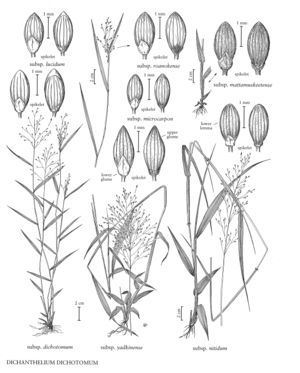Difference between revisions of "Dichanthelium dichotomum subsp. dichotomum"
FNA>Volume Importer |
FNA>Volume Importer |
||
| Line 7: | Line 7: | ||
|name=Dichanthelium dichotomum var. barbulatum | |name=Dichanthelium dichotomum var. barbulatum | ||
|authority=unknown | |authority=unknown | ||
| − | }}{{Treatment/ID/Synonym | + | }} {{Treatment/ID/Synonym |
|name=Panicum barbulatum | |name=Panicum barbulatum | ||
|authority=unknown | |authority=unknown | ||
| Line 18: | Line 18: | ||
}}<!-- | }}<!-- | ||
| − | --><span class="statement" id="st-undefined" data-properties=""><b>Culms </b>20-60 cm, usually slender, erect; nodes usually glabrous, lowermost nodes sometimes sparsely bearded with soft, retrorse hairs; internodes terete, green to purplish, glabrous; fall phase branching freely from the midculm nodes, producing dense clusters of reduced, flat to involute blades and reduced secondary panicles. <b>Cauline</b> sheaths usually glabrous, lowermost sheaths sometimes sparsely pubescent, margins glabrous or short-ciliate; blades usually 3.5-9 cm long, usually 5-7 mm wide (seldom wider), usually spreading, narrowly lanceolate, glabrous on both surfaces, bases constricted. <b>Primary</b> panicles well-exserted; branches few, flexuous, with fewer spikelets than all the other subspecies apart from subsp. lucidum. <b>Spikelets</b> 1.8-2.3 mm, ellipsoid, usually glabrous, rarely purplish at the base; upper florets 1.7-2 mm long, 0.7-1.0 mm wide. <b>2n</b> = 18.</span><!-- | + | --><span class="statement" id="st-undefined" data-properties=""><b>Culms </b>20-60 cm, usually slender, erect; nodes usually glabrous, lowermost nodes sometimes sparsely bearded with soft, retrorse hairs; internodes terete, green to purplish, glabrous; fall phase branching freely from the midculm nodes, producing dense clusters of reduced, flat to involute blades and reduced secondary panicles. <b>Cauline</b> sheaths usually glabrous, lowermost sheaths sometimes sparsely pubescent, margins glabrous or short-ciliate; blades usually 3.5-9 cm long, usually 5-7 mm wide (seldom wider), usually spreading, narrowly lanceolate, glabrous on both surfaces, bases constricted. <b>Primary</b> panicles well-exserted; branches few, flexuous, with fewer spikelets than all the other subspecies apart from <i></i>subsp.<i> lucidum</i>. <b>Spikelets</b> 1.8-2.3 mm, ellipsoid, usually glabrous, rarely purplish at the base; upper florets 1.7-2 mm long, 0.7-1.0 mm wide. <b>2n</b> = 18.</span><!-- |
-->{{Treatment/Body | -->{{Treatment/Body | ||
| − | |discussion=<p>Dichanthelium dichotomum subsp. dichotomum usually grows in dry to mesic woods. Its range extends from southern Ontario to Maine and south through Illinois and Missouri to eastern Texas and to the east coast of the United States and central Florida.</p> | + | |discussion=<p><i>Dichanthelium dichotomum </i>subsp.<i> dichotomum</i> usually grows in dry to mesic woods. Its range extends from southern Ontario to Maine and south through Illinois and Missouri to eastern Texas and to the east coast of the United States and central Florida.</p> |
|tables= | |tables= | ||
|references= | |references= | ||
| Line 41: | Line 41: | ||
|publication year= | |publication year= | ||
|special status= | |special status= | ||
| − | |source xml=https://jpend@bitbucket.org/aafc-mbb/fna-data-curation.git/src/ | + | |source xml=https://jpend@bitbucket.org/aafc-mbb/fna-data-curation.git/src/8f726806613d60c220dc4493de13607dd3150896/coarse_grained_fna_xml/V25/V25_1176.xml |
|subfamily=Poaceae subfam. Panicoideae | |subfamily=Poaceae subfam. Panicoideae | ||
|tribe=Poaceae tribe Paniceae | |tribe=Poaceae tribe Paniceae | ||
Revision as of 16:28, 18 September 2019
Culms 20-60 cm, usually slender, erect; nodes usually glabrous, lowermost nodes sometimes sparsely bearded with soft, retrorse hairs; internodes terete, green to purplish, glabrous; fall phase branching freely from the midculm nodes, producing dense clusters of reduced, flat to involute blades and reduced secondary panicles. Cauline sheaths usually glabrous, lowermost sheaths sometimes sparsely pubescent, margins glabrous or short-ciliate; blades usually 3.5-9 cm long, usually 5-7 mm wide (seldom wider), usually spreading, narrowly lanceolate, glabrous on both surfaces, bases constricted. Primary panicles well-exserted; branches few, flexuous, with fewer spikelets than all the other subspecies apart from subsp. lucidum. Spikelets 1.8-2.3 mm, ellipsoid, usually glabrous, rarely purplish at the base; upper florets 1.7-2 mm long, 0.7-1.0 mm wide. 2n = 18.
Discussion
Dichanthelium dichotomum subsp. dichotomum usually grows in dry to mesic woods. Its range extends from southern Ontario to Maine and south through Illinois and Missouri to eastern Texas and to the east coast of the United States and central Florida.
Selected References
None.
